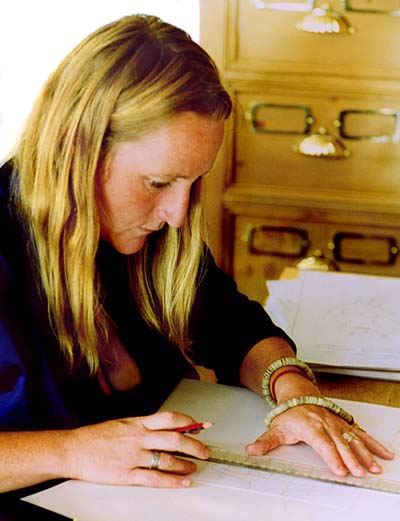
Ngakma Métsal Takrig Dé’gyür Wangmo
Me rTsal sTag rig bDe ’gyur dBang mo
It makes me extremely happy to be ordained into the gö-kar chang-lo’i dé, and to be one of Khandro Déchen Tsédrüp Rolpa’i Yeshé’s thangka painting students.
I have the great good fortune to have two wonderful parents – both of whom have always fashioned items. They have been inspirational, both in terms of practical invention and artistic creativity. However, I went to the sort of school where pupils were only encouraged in art if it was felt they were incapable of anything else. Due in part to lack of opportunity I only developed meagre artistic skills – which I picked up at home in a fairly ad hoc manner. I always harboured dreams of going to art college. Even after having studied an academic subject at university, drifted around, given birth to my stunning son; the yearning to create was still there. Studying traditional five element acupuncture for three years engendered an abiding passionate interest in the magic dance of the elements, so on meeting Ngak’chang Rinpoche and Khandro Déchen a most wonderful life began. I became an apprentice and was immediately drawn to the idea of learning thangka painting.
The
first time I mentioned to Ngak’chang Rinpoche
that I was interested in thangka painting I remember saying: I’m
not an artist, I just like copying and colouring in.
Ngak’chang Rinpoche said: Marvellous.
In that case, you just might make an excellent thangka painter.
I
did not really understand this at the time, but now I have a little more
insight into the nature of the thangka painters ‘art’ I feel very
strongly that it is the midwifery of which Khandro Déchen
speaks.
Thangkas are not merely pieces of art – they are an extraordinarily vital support for practice.
My mother makes beautiful things that are often useful. My father makes useful things that are often beautiful. Beauty and purpose together have always mattered a lot to me – I would rather have a beautiful knife than a beautiful painting (and now I have the most beautiful knife in the world – Ngak’chang Rinpoche’s 11-inch reproduction 1850s Gentleman’s Dress-Bowie made by Idaho Knifeworks). I suspect that I have always been slightly uncomfortable with not having a good reason for having something.
I feel that—as Tantric practitioners—we need all the help we can get, so to be involved to any degree with producing these images is a great privilege – especially when they may be of use to someone. My project of depicting enlightened women—the 25 female disciples of Padmasambhava and Yeshé Tsogyel—feels very much like midwifery to me. I am helping to form line drawings of women for whom there are no available images. I often feel that my rôle is almost just to keep getting things wrong so that there is something for Ngak’chang Rinpoche and Khandro Déchen to ask me to change. The process is truly birthing form out of emptiness.
It
is quite wonderful when the form I have produced dissolves back into emptiness
at the instigation of my Lamas. I don’t ever finish a picture – I just
take it to a certain point where Ngak’chang Rinpoche works on it, then Khandro
Déchen takes it over and completes it. I do not have a final product
of which I can say: I drew that.
There is no
autograph. All sense of recognition is irrelevant other than seeing the
pleasure of my Lamas when I get something near enough right. As with all the
many possible practices of the Aro gTér, thangka
painting provides unlimited teachings on all levels and in all spheres:
devotion, integration, and symbolism, to name but three.
To date, the title ‘thangka painting student’ might be a slight misnomer, as I have yet to wield paintbrush on canvas. My life being so full, progress is frustratingly slow – but I know that the time will come when I will paint, and it will be a splendid thing.
When I first visited Ngak’chang Rinpoche and Khandro Déchen to ask them if I could become an apprentice, I took them as a gift an appalling silk image of Khyungchen Aro Lingma which I had painted for them. Seeing it on occasion since has been a very useful reminder of what an awful lot I have yet to learn. With the immense good fortune of having the kindest and most inspiring teachers however – learn I will!
The opportunity to spend time working with Ngak’chang Rinpoche and Khandro Déchen is the most precious thing in my life and I am also completely blessed by the inspirational company of the other thangka painting students – what marvellous people they are. How lucky I am.
